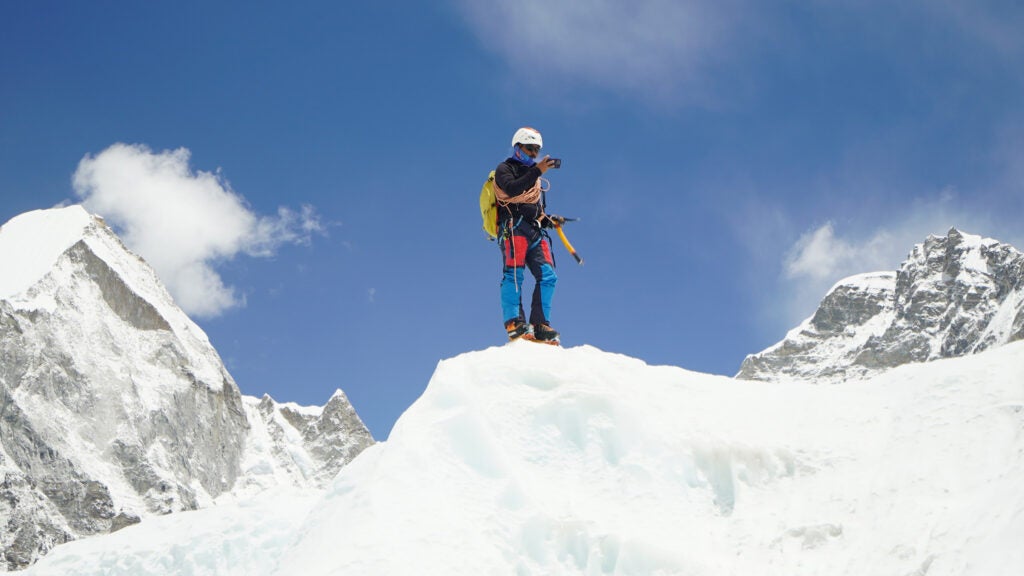No products in the cart.
Outdoor Adventure
For Nepali Guides on Mount Everest, Daily Life Is Full of Danger
Every year, a vast ecosystem of Nepali mountain workers helps hundreds of climbers ascend and then descend Mount Everest. In 2024, approximately 1,500 of these guides, porters, cooks, rope fixers, and expedition operators will support the 414 paying clients on the peak.
Abiral Rai, 33, is one of these unsung heroes. Abiral is not Sherpa—he is from the Thulung Rai ethnic group, one of many found across Nepal’s eastern hills. He grew up in a small village in the Solukhumbu district of eastern Nepal, about a six-day walk south of Everest Base Camp. He began his career at age 18 by portering loads of rice, soda, and other supplies for the commercial trekking industry in the Khumbu Valley, and then ascended through the expedition industry’s labor force until he became a high-altitude mountain guide. In 2019 Abiral completed his certification with the International Federation of Mountain Guides Association (IFMGA).
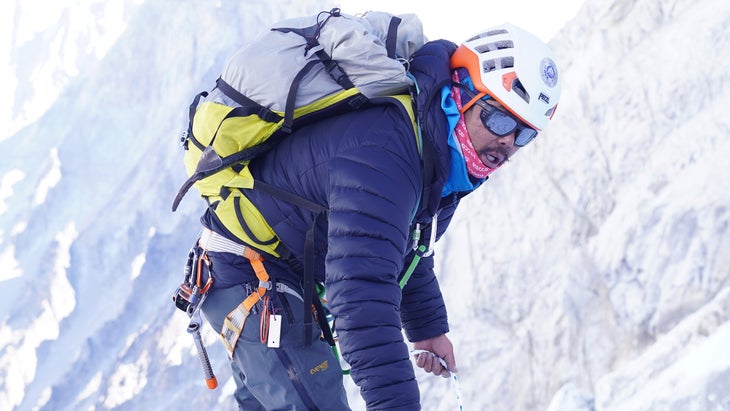
This year, Abiral is working as a VIP guide for expedition companies Climbing The Seven Summits and TAG Nepal to help his client, a 29-year-old business owner from Singapore named Blake Li, reach the top. Abiral spoke to Outside shortly after he and Li returned from their second acclimatization rotation on Everest—a hike to higher elevations to prepare their bodies for the summit push. He gave us a glimpse of daily life on the world’s highest peak.
Day 1: Navigating the Khumbu Icefall
Midnight, Mount Everest Base Camp (17,500 feet)
Abiral wakes alone in his tent and eats a quick breakfast of porridge, boiled eggs and toast. He gives his assistant, Tenzing Sherpa, the 22-pound bag of high-altitude gear his client packed the night before. Tenzing is paid by the weight that he carries, and on this trip he has chosen to carry a double-load totaling 70 pounds. Then, Abiral stuffs a sleeping bag, climbing and safety gear, a mattress, food, and water into his pack. He and Tenzing meet Li, and the three start hiking toward the peak. This is not their summit push, but a four-day acclimatization ascent up to Camp III at 23,500 feet. It’s still dark as they head down the trail, and their headlamps light the way to the Khumbu Icefall.
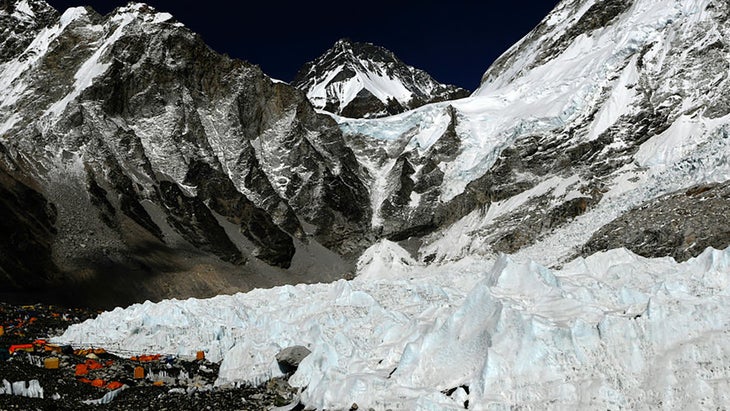
2 A.M., Khumbu Icefall (18,000 ft)
Abiral and Li reach the base of the notorious Khumbu Icefall, the dangerous glacier on the peak’s southwest face that is riddled with crevasses and collapsing ice blocks. Here, they both don crampons and remove warm layers to avoid overheating and soaking themselves with sweat. Due to their ability to travel quickly together, they are among the first to reach the tricky section. Every year, the Icefall Doctors, the route fixers who focus specifically on this section, establish the ever-changing pathway through the dangerous glacier. They break the route into sectors, assigning each a number from one to five.
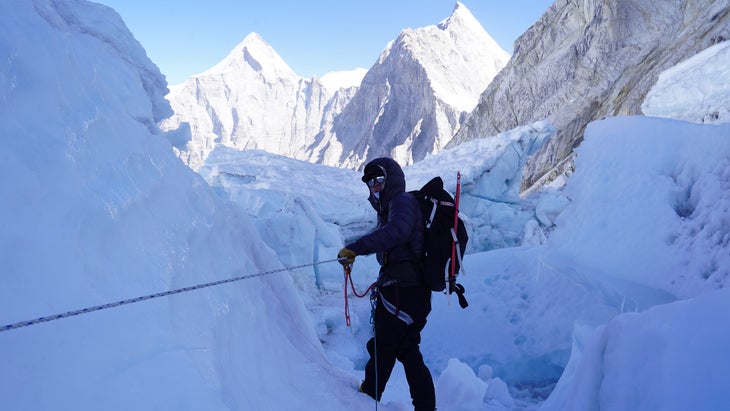
3:30 A.M. The Football Ground (18,300 ft)
Abiral and Li pass sectors one and two quickly, stopping just once for a drink. They encounter the first large crevasses on sector three—a massive crack in the ice that’s bridged by aluminum ladders and safety ropes. Abiral crosses the ladders first and then holds the safety lines tightly to provide more support for Li. After they complete the third sector, they reach a wide-open area of the icefall known as “the football ground.” This area is safe from collapsing ice and rockfall, so the pair rests for ten minutes.
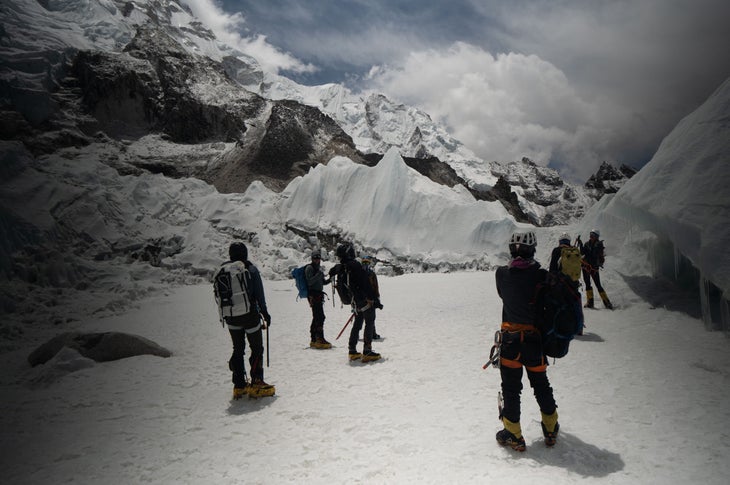
5:45 A.M. Danger Is Everywhere (19,000 ft)
Sector four of the Icefall presents two sizable dangers: unstable snow bridges across deep crevasses, and huge seracs towering overhead. Abiral walks faster through this section to minimize their exposure to avalanches. Traveling under darkness means the air temperature is colder, and the glacier ice is more firm. This reduces but does not eliminate the risk of avalanches. Just as the sun begins to rise, they meet a group of 30 load-carrying workers and climbers waiting beneath a 150-foot tall vertical wall of blue ice. Two nylon ropes dangle down the steep face of this terrifying fifth and final sector. Progress is slow, as the workers with heavy loads must remove their backpacks, climb up the fixed ropes, and then haul their gear up behind them. After waiting for several minutes, Abiral jockeys his way onto one of the nylon ropes and uses an ascender called a “Jumar” to scale the sheer incline. Once at the top, he hammers two aluminum anchors into the ice, secures his own guide rope, and drops it down to Li. Li ascends the fixed rope while Abiral’s guide rope adds an extra level of safety.
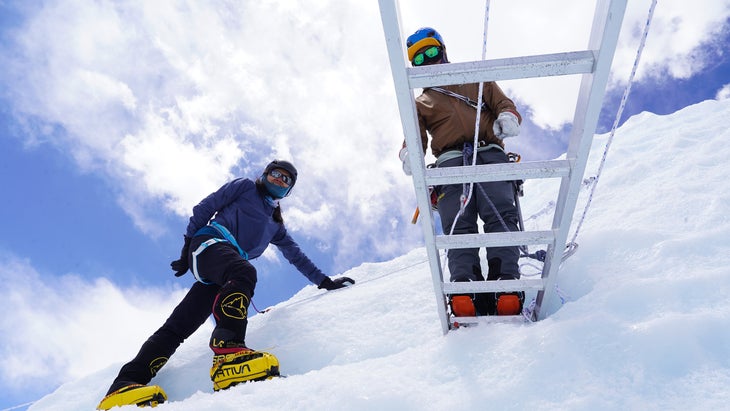
7:15 A.M. Reaching Camp I (19,900 ft)
Past the vertical ice, the route turns into a dangerous glaciated plateau, strafed by occasional rockfall. Abiral ties a rope to Li, and the other end to himself for safety, allowing one of them to quickly stop a fall should the other fall into a crevasse. They move as quickly as possible through this section. The sun is still low in the sky as they walk into Camp I. They find their section of tents, which were set up days before by other workers on their team. Abiral unloads their personal gear and sets up sleeping bags and mattresses in the tent that he will share with Li. He then heats water on his small gas stove and they drink tea and eat the last of their trail snacks. They will spend the rest of the day here, chatting with other climbers, resting, and allowing their bodies to acclimatize to the altitude.
5:30 P.M. An Early Bedtime
Abiral and his client have spent the last ten hours resting in Camp 1: hydrating, going on short walks, talking to other climbers, and trying their best to avoid the burning sunlight. Dinnertime comes early and with little fanfare. Abiral cooks a freeze-dried meal for Li with his camp stove. He eats a large bowl of mashed potato flakes with chili powder. They retire to the tent and are asleep by 8 P.M.
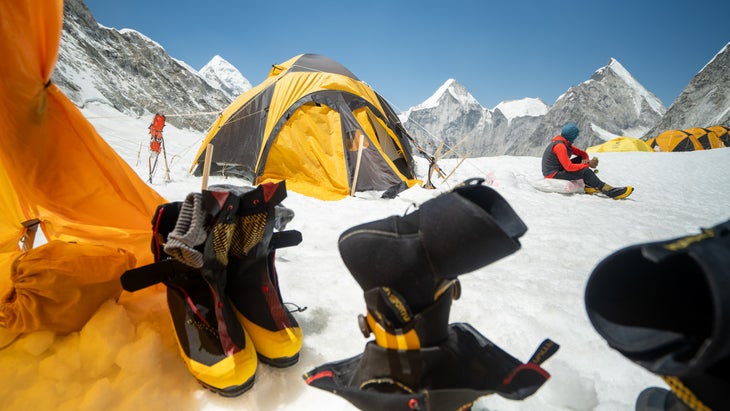
DAY 2: Avoiding Rockfall in the Western Cwm
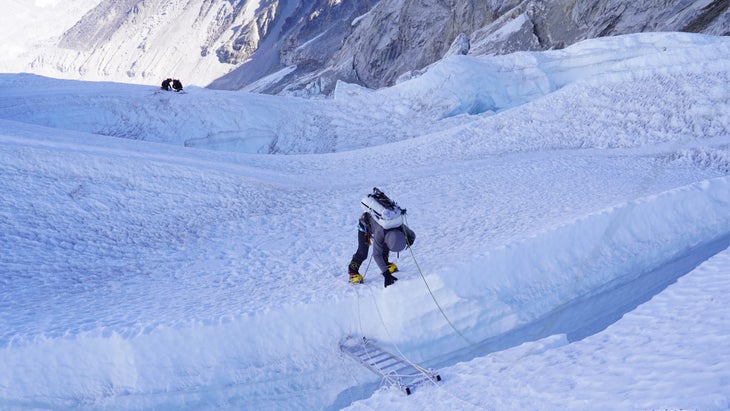
6 A.M. Sherpa Oatmeal (19,900 feet)
Abiral wakes in the dark and cooks another freeze-dried meal for his client. Then, he cooks his own food: a large helping of “tsampa,” a Sherpa staple made of roasted buckwheat flour. They get onto the trail. Even though the walk to Camp II is short—less than two miles with 1,500 feet gained in altitude—it’s safer to complete the journey early in the morning before the sun warms the glacier and triggers avalanches along the route. Abiral also prefers to walk in the cool temperatures—direct sunlight slows clients down. The same journey may take twice as long during the heat of the day, and the exposure can lead to painful sunburn. As they walk, Abiral keeps an eye open for rockfall coming off the Nuptse face to their right.
9 A.M. A Short Journey to Camp II (21,000 feet)
Abiral and his client arrive at Camp II, which resembles a small, bustling city atop a rocky outcropping. The collection of tents is located halfway up the wide and dramatic undulating valley called the Western Cwm (pronounced “coom.”) There are 300 people here, the CTSS/TAG Nepal camp alone boasting 53 people. Guides, cooks, assistants and other workers mill about busily. Abiral prepares the tent, and then he and his client rest. Around noon, they meet in the heated dining tent and enjoy lunch.
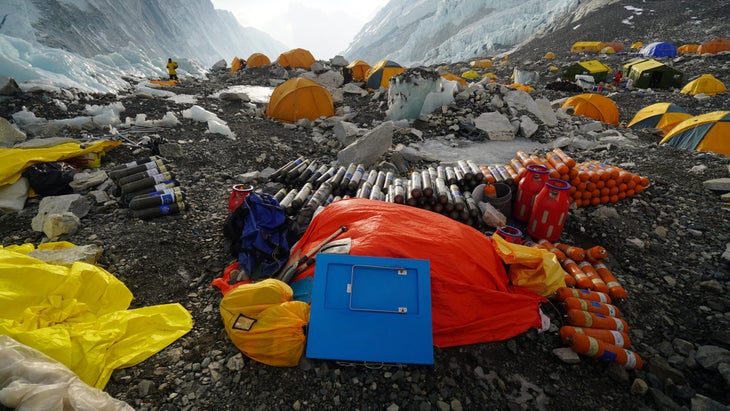
5 P.M. Speeding up the Ascent
Abiral is impressed by Li’s strength at altitude. After discussing with him, Abiral decides to skip the rest day in Camp II and to instead venture higher onto the peak the next morning. He and his client eat dinner early and then head back to their tent. They are asleep by 6:30 P.M.
Day 3: A Punishing Climb Into Thin Air
3 A.M. Departure in the Dark (21,000 feet)
Abiral eats a quick breakfast of porridge, toast, and an omelet. He packs a light bag of snacks, two liters of water, and his warmest climbing gear. Above Camp II, the terrain and the temperature demands that he and the client don a set of heavier boots, gloves, and a full down suit. They rope themselves together, leave camp at 5:30 A.M., and walk across the glaciated valley towards the looming Lhotse Face.
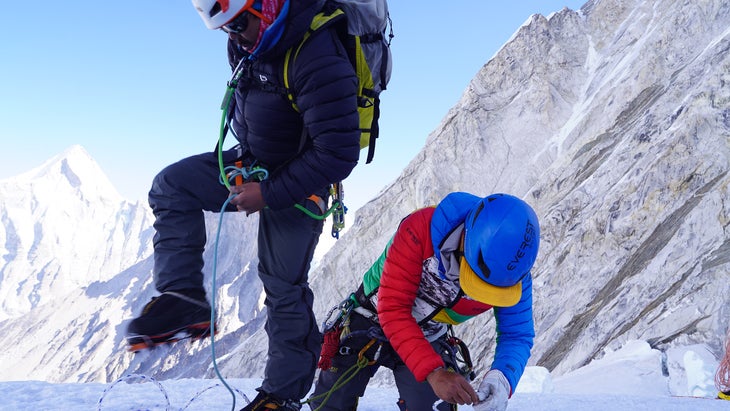
7:30 A.M. A Wall of Rock and Ice (21,500 ft)
After nearly two hours of walking, Abiral and Li reach the base of the Lhotse Face, an intimidating, nearly-vertical 2,000-foot wall of rock and ice leading up to Camp III. Here, the climbing requires using jumars that allow climbers to ratchet themselves up the fixed ropes. This year, heavy winter snowfall never arrived on Everest, and now the route is mostly ice and rock. The hard surface makes the climbing more difficult and increases the potential for injury or death. Loose rocks and ice tumble down the slope as Abiral and Li begin the ascent. They started their day so early so that they could be alone on the tricky section, and avoid the famous traffic jams of climbers following in their footsteps. The Lhotse Face is often where photographers snap images of hundreds of climbers standing in a queue to reach the top. Abiral knows that at this altitude, speed means safety. Li’s strength on the jumar line is an asset—on previous ascents, Abiral has had to rope himself to clients that struggled on the incline and tug them upward. But this time, he and Li ascend at the same pace.
9 A.M. Reaching Camp III (23,500 ft)
After reaching the top of the Lhotse Face, Abiral and Li follow fixed ropes across exposed terrain for another few hundred feet to reach Camp III. The jumble of tents—both standing and shredded—sit between rocks, ice, and piles of gear. A few workers are chipping away at the bare ice to make room for additional tents. Abiral snaps a few photos and eats some chocolate. But this is a brief moment of enjoyment. Peering down the Lhotse face, Abiral sees a long line of climbers, guides, and high-altitude workers beginning to ascend the steep roped section. This gaggle of ascending people will create headaches for anyone heading downhill. So, after just 15 minutes, Abiral makes the decision to head down to minimize waiting time on the ropes. They don rappelling devices and begin to descend.
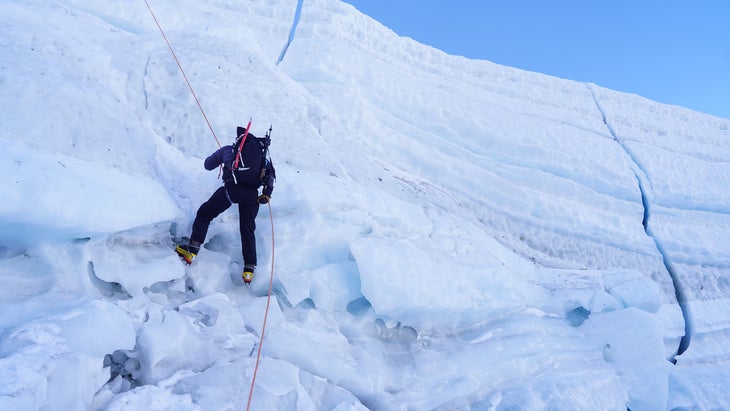
11 A.M. Traffic Jam (22,500 ft)
In many places on the Lhotse Face, there is only a single rope for both ascending and descending climbers. Despite moving quickly, Abiral and Li must wait for ascending climbers to pass. They locate safe anchors on the lines for each pass—it’s a time consuming but necessary step to ensure their safety. Rappelling down the face takes only 45 minutes without traffic, but today it takes Abiral’s group nearly two hours. They return to Camp II in time for lunch at noon. At 12:15 P.M. it begins snowing heavily, depositing more than 8 inches at Camp II over the course of the afternoon. Abiral is delighted by the new powder—it will make the Lhotse Face safer when they return in a week for the summit push.
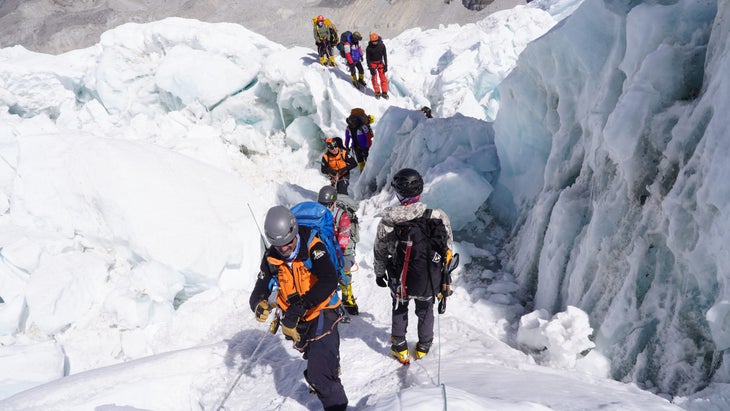
Day 4: Back to Base Camp
4 A.M. An Early Descent (21,000 ft)
Abiral wakes up in the dark and packs his high-altitude boots, gloves, and other gear into a duffel bag that will stay in Camp II until he returns for the summit push in a week or so. After a quick breakfast, he and his client rope together and set out into the fresh snow below camp. The route they followed two days ago is now gone, and they must navigate slowly and carefully, following small flags that indicate safe passage through the glaciated terrain. By 6:30 A.M. they reach Camp I, where they retrieve the filled poop bags that they stashed on the way up. They hydrate and descend into the Khumbu Icefall.

7 A.M. A Final Bottleneck (19,000 feet)
As Abiral and his client arrive at the vertical wall of ice in the Khumbu Icefall’s fifth sector, they encounter a long line of heavily-laden workers and climbers waiting to descend. They wait for 45 minutes for the traffic jam to ease, and to save time Abiral fixes his own anchor into the ice and lowers his client down the cliff using his personal guide rope. This practice gives Li an added layer of safety in the case of a fall. Abiral quickly follows, rappelling down the fixed ropes before another climbing group can get on. As they continue the descent, Abiral notices that the icefall route has already changed significantly since they climbed through only two days ago. There are new crevasses to cross and fresh ladders. In some places, the old route has disappeared into a crevasse, or been buried by falling ice. By 10:30 A.M., they reach the foot of the icefall and remove their crampons. Abiral estimates that they have passed at least 70 clients, workers, and guides since departing Camp II.
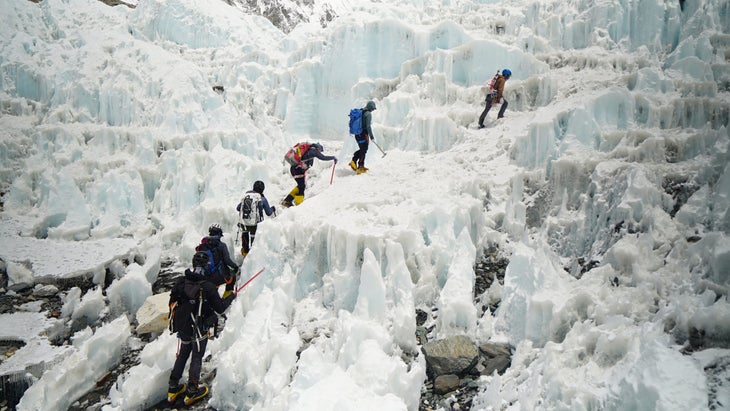
11 A.M. Safe At Home (17,500 ft)
Abiral and Li return to the relatively thick air of Base Camp, where hot drinks and lunch are waiting for them. Abiral has maintained close radio contact with the Base Camp team throughout the climb, and they know what Abiral and Li like to eat. Li downs a sandwich, boiled vegetables, fried fish and a salad. Abiral eats a giant plate of rice and lentils with chicken. After lunch, Abiral arranges laundry and a hot shower for Li. He does not schedule bathing time for himself, as he believes that showering weakens the body at extreme altitude. Abiral notices that the other clients and guides are starting to develop a slight cough from being at altitude for so long, and he doesn’t want to do anything that might weaken his immune system. He returns to his tent and video calls his wife to let her know he is safely back in Base Camp. In the afternoon, he scrolls through his latest photos, updates his Instagram, and prepares for the clients-versus-guides ping-pong tournament scheduled for the next day.
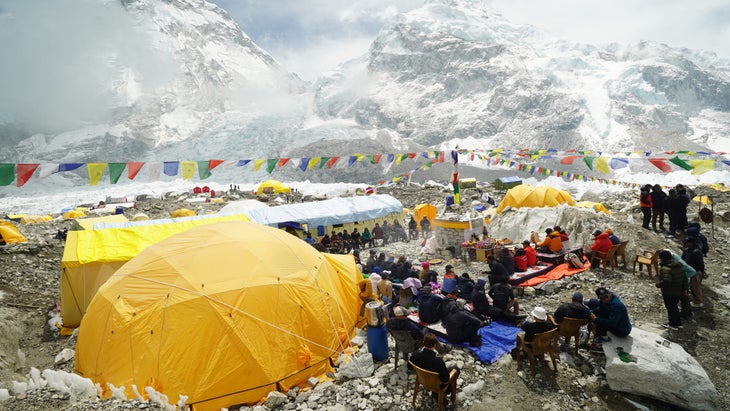
Source link

